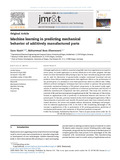Citation link:
http://dx.doi.org/10.25819/ubsi/10055Files in This Item:
| File | Description | Size | Format | |
|---|---|---|---|---|
| Machine_learning_in_predicting_mechanical_behavior.pdf | 3.8 MB | Adobe PDF |  View/Open |
| Dokument Type: | Article | metadata.dc.title: | Machine learning in predicting mechanical behavior of additively manufactured parts | Authors: | Nasiri, Sara Khosravani, Mohammad Reza |
Institute: | Fakultät IV - Naturwissenschaftlich-Technische Fakultät | Free keywords: | Desktop Manufacturing, Layer Manufacturing, Additive Manufacturing, 3D Print | Dewey Decimal Classification: | 670 Industrielle und handwerkliche Fertigung | GHBS-Clases: | ZHU | Issue Date: | 2021 | Publish Date: | 2022 | Source: | Journal of Materials Research and Technology ; 14(2021), S. 1137-1153. - https://doi.org/10.1016/j.jmrt.2021.07.004 | Abstract: | Although applications of additive manufacturing (AM) have been significantly increased in recent years, its broad application in several industries is still under progress. AM also known as three-dimensional (3D) printing is layer by layer manufacturing process which can be used for fabrication of geometrically complex customized functional end-use products. Since AM processing parameters have significant effects on the performance of the printed parts, it is necessary to tune these parameters which is a difficult task. Today, different artificial intelligence techniques have been utilized to optimize AM parameters and predict mechanical behavior of 3D-printed components. In the present study, applications of machine learning (ML) in prediction of structural performance and fracture of additively manufactured components has been presented. This study first outlines an overview of ML and then summarizes its applications in AM. The main part of this review, focuses on applications of ML in prediction of mechanical behavior and fracture of 3Dprinted parts. To this aim, previous research works which investigated application of ML in characterization of polymeric and metallic 3D-printed parts have been reviewed and discussed. Moreover, the review and analysis indicate limitations, challenges, and perspectives for industrial applications of ML in the field of AM. Considering advantages of ML increase in applications of ML in optimization of 3D printing parameters, prediction of mechanical performance, and evaluation of 3D-printed products is expected. |
Description: | Finanziert aus dem Open-Access-Publikationsfonds der Universität Siegen für Zeitschriftenartikel |
DOI: | http://dx.doi.org/10.25819/ubsi/10055 | URN: | urn:nbn:de:hbz:467-21324 | URI: | https://dspace.ub.uni-siegen.de/handle/ubsi/2132 | License: | http://creativecommons.org/licenses/by-nc-nd/4.0/ |
| Appears in Collections: | Geförderte Open-Access-Publikationen |
This item is protected by original copyright |
Page view(s)
345
checked on Apr 8, 2025
Download(s)
644
checked on Apr 8, 2025
Google ScholarTM
Check
Altmetric
This item is licensed under a Creative Commons License


